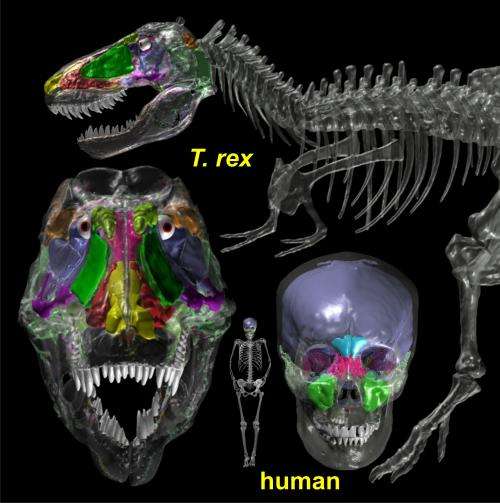(PhysOrg.com) -- A University of Alberta-led research team has taken a rare look inside the skull of a dinosaur and come away with unprecedented details on the brain and nasal passages of the 72 million year old animal.
Lead researcher Tetsuto Miyashita, a U of A master's student in paleontology, examined the armoured skull of a Euoplocephalus, a six-metre long plant eater. The skull, which had been sitting in the U of A's paleontology collection, was broken, allowing Miyashita and his colleagues a unique view of the interior nasal cavities and details of blood vessels.
Skull of the ankylosaur dinosaur Euoplocephalus tutus (AMNH FR 5405), revealing the brain and nasal cavity (olfactory region in red, airway in yellow). The arrow shows the tortuous airway. Rendered from CT scans using Amira and QuickTime by Ryan Ridgely, and labeled by Jason Bourke.
The researchers obtained CT scans from undamaged Euoplocephalus skulls to reconstruct the twisted, looping nasal passages and brain chamber. The team concluded Euoplocephalus had good senses of smell and hearing.
Skull of the ankylosaurian dinosaur Euoplocephalus tutus (AMNH FR 5405), revealing the brain and nasal cavity (Olfactory region in red, airway in yellow). Rendered from CT scans using Amira and QuickTime by Ryan Ridgely, and labeled by Jason Bourke.
Skull of the ankylosaurian dinosaur Euoplocephalus tutus (AMNH FR 5405), revealing the brain and nasal cavity (Olfactory region in red, airway in yellow). Rendered from CT scans using Amira and QuickTime by Ryan Ridgely, and labeled by Jason Bourke.
The researchers say the entire brain of a Euoplocephalus would fit inside a coffee mug, but the size was not small for a dinosaur. The dinosaur may have generated sound through its looping nasal passages, enabling it to communicate with other Euoplocephalus. The reconstructed inner ear was tuned for this "nasal roar" because the length of the ear indicates that the dinosaur could pick up low-frequency sounds.
Provided by University of Alberta





















